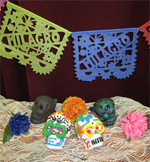Join us this October for three creative Día de los muertos-themed workshops at Milagro! This series is an offering to your crafty side as instructors Samuel Becerra and Estela Robinson each lead classes in making art traditionally found on the altars during the Day of the Dead. You can sculpt your own flauta de calavera (skull-shaped flute) with Samuel and then learn how to play traditional flutes and melodies. Delicate papel picado (cut paper) can decorate your home after a class with Estela, while an evening decorating sugar skulls can satisfy any need for sweets.
Here’s the schedule:
• Papel picado with Estela Robinson — Wednesday Oct. 24, 6-8 p.m., $5 Papel picado is a decorative craft made out of paper cut into elaborate designs. Stings of the delicate banners are often displayed for festive occasions, such as Día de los muertos, Christmas, and Easter, as well as weddings, baptisms, and christenings. Common themes include birds, floral designs, and skeletons. In Mexico, papel picado is especially incorporated into altars during the Día de los muertos. During the middle of the nineteenth century, people were forced to buy products from hacienda stores, where they encountered tissue paper. They could stack these sheets 40 to 50 pieces thick and use a chisel to create their intricate designs.
• Sugar skull decorating with Estela Robinson — Wednesday Oct. 31, 6-8 p.m., $5 Sugar art was brought to the New World by Italian missionaries in the 17th century. Mexico, abundant in sugar production and unable to buy fancy imported European church decorations, learned quickly from the friars how to make sugar art for religious festivals. Molds were made of clay and the sugar decorations were used as ofrendas (offerings) to adorn the church as well as altars and gravestones on Día de los muertos, November 1st and 2nd. Smaller skulls are placed on the altar on November 1st to represent the children who have deceased. On November 2nd they are replaced by larger, more ornate skulls which represent the adults. These decorative skulls can have the name of the deceased on the forehead and are decorated with stripes, dots and swirls of icing to enhance the features of the skulls. The designs are usually whimsical and brightly colored, not morbid or scary. Feathers, beads or colored foils are «glued» on with the icing to create highly ornate skulls.
• NEW DATE! Flautas de calavera with Samuel Becerra— Saturday Nov. 3, 1-3 p.m., $10. Pre-Columbian flutes vary from flute to flute in shape, figure and tone. The difference is very specific as each flute was built for a particular ceremony. The skull-shaped flutes are played in Día de los muertos ceremonies and serve as decoration on the altars, especially those of musicians.
Ave., Monday-Friday, 8:30 a.m.-5 p.m. Prepayment or credit card guarantee
required at time of registration.
About the Instructors
Samuel Becerra played music for years, but when he started playing pre-columbian music he couldn’t find traditional instruments. So he learned how to make his own! Three years ago he began researching traditional methods of building flutes, which led him to master flute builder Xavier Quijas in LA. Samuel has taken these methods and added his own artistic vision to make a wide range of instruments. He loves the satisfaction that comes from playing his own flutes. In fact, he just finished recording an album using all his own instruments! On top of musical instruments Samuel creates sculptures, masks, calaveras and more.
Estela Robinson is a crafty lady: creative and cunning. Estela is a self-taught artist, always looking for her next project. What started as her mom teaching her to crochet at age 7 has turned into a creative eye and the need to know “How does someone do that??!!” Estela’s crafts include more than the traditional Hispanic crafts like Calaveras de azúcar and papel picado. Her latest interest is in metal clay, sculpting pieces out of a type of clay that becomes metal after it is fired. She says that part of the fun is the research for materials and techniques. Finding new materials is inspiration for new projects. Estela’s motto: “I can totally make that.”


